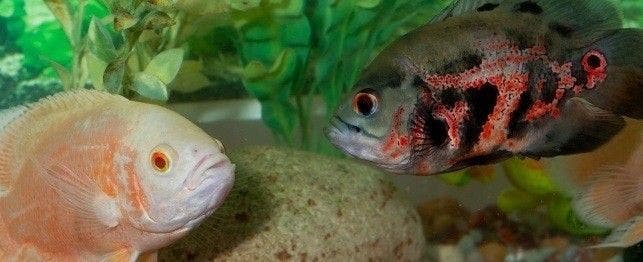
Choosing Oscars
The oscar (Astronotus ocellatus), also referred to as peacock cichlid or velvet cichlid, is a very easy animal to keep and care for. Oscars are a type of South American cichlid, commonly found in the Amazon River basin, eastern Venezuela, and Guyana. They have a tremendous amount of personality and are very interesting to watch.
Oscars come in several color variations, including the standard variety, which is brown in color with red to yellow flecks; the red variety, which has a large amount of red pigment all over the body; and the tiger, which is a brown fish that has bands of coloration in a tiger-striped pattern. These stripes range from red to yellow in coloration. Occasionally, albino or amelanistic (having no pigment) oscars can also be found in the hobby.
Oscars are very tolerant of a wide variety of water quality conditions. This makes them very easy to keep, especially for beginning aquarists. Despite their acceptance of a wide range of water quality parameters it is still best to maintain them at optimal conditions. Oscars, like other South American cichlids, do best in soft water with a hardness of about 100. The pH is best if slightly acidic (6.0 to 6.5). Optimal temperatures for oscars are between 72 and 82 degrees Fahrenheit.
Oscars are easy to feed and generally very voracious eaters. Their willingness to eat a variety of foods also makes them very easy to keep. Although their appetites may seem endless it is important that the animals not be overfed. Overfeeding the animals will result in the production of larger amounts of waste products and the accumulation of toxic compounds. While oscars may be more tolerant of these toxins, too much nitrogen waste buildup will result in their demise just like other fish species.
Live feeder fish are the best food for these animals. Should you be unable or unwilling to feed live fish, pelleted or frozen fish feeds are a good alternative. Flake foods will work well for smaller animals but can be quite messy and difficult for larger animals to consume. Regardless of what you choose to feed it is always best to provide a variety of foods to your fish. Some people have even fed their larger oscars dog food. This is not recommended, however, as these feeds are not nutritionally formulated for fish and could result in health problems if used as the sole diet over a long period of time.
Oscars are very popular in the pet trade and generally easy to find in pet stores. They can be found in a variety of sizes and will grow up to 12 inches long. It is important that aquarists keeping oscars realize that these animals will grow very rapidly and eat anything they can fit in their mouths. For this reason it is best to keep them alone or with another oscar or other South American cichlids of similar size. (Large oscars may still become aggressive with other fish of similar size and may need to be separated.) Some people have said that small juvenile oscars can be kept in community tanks with other fish. This is strongly discouraged, unless you want to gradually see your other fish disappear as the oscar grows and is able to eat them.
Their tank requirements are very minimal and it is important to realize that these animals grow very quickly and will require an aquarium large enough to accommodate them. Decorating a tank for oscars is likely to be a very frustrating exercise. These animals often dig up any plants (live or artificial) and knock over any decorations you choose to put in the aquarium. Additionally, they are likely to dig and move gravel around the aquarium.
In summary, oscars have a great deal of personality, are very easy animals to keep, and are an excellent choice for first time aquarists. The major considerations in keeping these animals are the size of the aquarium they may need, and whether or not you want to just keep one or two fish in a fairly plain aquarium. If these are concessions you are willing to make, oscars are hard to beat!